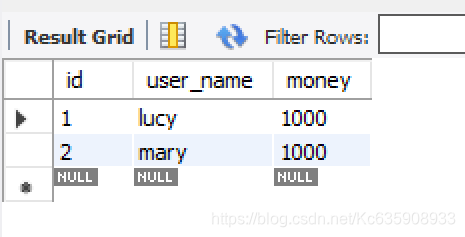源代码(所有代码均可直接运行):https://github.com/KUANG-CHENG/Spring
Spring5.0 — 事物操作管理相关代码
操作环境:IDEA
如果对您有帮助,请点个赞,谢谢支持!
文章目录
1.Spring事务管理基本概念
1)事务是数据库操作最基本单元,逻辑上一组操作,要么都成功,如果有一个失败所有操作都失败
2)典型场景:银行转账 张三 转账 100 元 给 李四; 张三少 100,李四多 100
3) 事物四个特性(ACID):
(1)原子性 — 不可分割
(2)一致性 — 操作前后总量不变
(3)隔离性 — 多事物操作不产生影响
(4)持久性 — 提交之后,表中数据会发生变化
2.事务管理案例
1)在数据库 userdb 中创建 tb_account 数据表,添加数据
( lucy 和 mary 每人具有1000元钱)

2)创建 service,搭建 dao,完成对象创建和注入关系
//(1)service 注入 dao,在 dao 注入 JdbcTemplate,在 JdbcTemplate 注入 DataSource
@Service
public class UserService {
//注入 dao
@Autowired
private UserDao userDao;
}
@Repository
public class UserDaoImpl implements UserDao {
@Autowired
private JdbcTemplate jdbcTemplate;
}
3)在 dao 创建两个方法:多钱和少钱的方法, 在 service 创建方法(转账的方法)
// UserDao接口函数
public interface UserDao {
public void addMoney();
public void reduceMoney();
}
// UserDaoImpl实现类
@Repository
public class UserDaoImpl implements UserDao {
@Autowired
private JdbcTemplate jdbcTemplate;
//lucy 转账 100 给 mary
//少钱
@Override
public void reduceMoney() {
String sql = "update t_account set money=money-? where username=?";
jdbcTemplate.update(sql,100,"lucy");
}
//多钱
@Override
public void addMoney() {
String sql = "update t_account set money=money+? where username=?";
jdbcTemplate.update(sql,100,"mary");
}
}
@Service
public class UserService {
//注入 dao
@Autowired
private UserDao userDao;
//转账的方法
public void accountMoney() {
//lucy 少 100
userDao.reduceMoney();
//mary 多 100
userDao.addMoney();
}
}
4)测试结果
测试成功! lucy 减少 100 元, mary增加 100 元。

5)对于出现异常的考虑
执行到一半,程序报错 — 转账会出现什么结果??
/**
上边代码正常执行没有问题,
但是如果代码执行过程中出现异常,有问题,如下模拟异常!
*/
@Service
public class UserService {
//这里执行后将会产生错误(异常),lucy 少 100后,mary不会多 100,这就不对了!!
private UserDao userDao;
//转账方法
public void accountMoney(){
userDao.reduceMoney();//lucy 少 100
int x=10/0;
userDao.addMoney(); //mary 多 100
}
}
//解决上边的异常方法——【编程式事务(传统方法)】
//转账的方法
public void accountMoney() {
try {
//第一步 开启事务
//第二步 进行业务操作
//lucy少100
userDao.reduceMoney();
//模拟异常
int i = 10/0;
//mary多100
userDao.addMoney();
//第三步 没有发生异常,提交事务
}catch(Exception e) {
//第四步 出现异常,事务回滚
}
}
3.Spring事物操作具体介绍
1、事务添加到 JavaEE 三层结构里面 Service 层(业务逻辑层)
2、在 Spring 进行事务管理操作 ;两种方式:编程式事务管理、声明式事务管理(推荐使用)
3、声明式事务管理 (1)基于注解方式(推荐使用) (2)基于 xml 配置文件方式
4、在 Spring 进行声明式事务管理,底层使用 AOP 原理
5、Spring 事务管理 API :提供一个接口,代表事务管理器,这个接口针对不同的框架提供不同的实现类
3.1 声明式事务管理(基于注解方式)
1)Spring 配置文件 — " bean1.xml "
<?xml version="1.0" encoding="UTF-8"?>
<beans xmlns="http://www.springframework.org/schema/beans"
xmlns:context="http://www.springframework.org/schema/context"
xmlns:xsi="http://www.w3.org/2001/XMLSchema-instance"
xmlns:util="http://www.springframework.org/schema/util"
xmlns:aop="http://www.springframework.org/schema/aop"
xmlns:tx="http://www.springframework.org/schema/tx"
xsi:schemaLocation="http://www.springframework.org/schema/beans http://www.springframework.org/schema/beans/spring-beans.xsd
http://www.springframework.org/schema/context https://www.springframework.org/schema/context/spring-context.xsd
http://www.springframework.org/schema/aop http://www.springframework.org/schema/aop/spring-aop.xsd
http://www.springframework.org/schema/tx http://www.springframework.org/schema/tx/spring-tx.xsd">
<!--配置数据库连接池-->
<bean id="dataSource1" class="com.alibaba.druid.pool.DruidDataSource"
destroy-method="close">
<property name="url" value="jdbc:mysql:///userdb" /><!--数据库的地址-->
<property name="username" value="root" /><!--用户名-->
<property name="password" value="Kc635908933" /><!--密码-->
<property name="driverClassName" value="com.mysql.jdbc.Driver" /> <!--驱动名称-->
</bean>
<!-- 组件扫描 -->
<context:component-scan base-package="com.spring"></context:component-scan>
<!-- JdbcTemplate 对象 -->
<bean id="jdbcTemplate" class="org.springframework.jdbc.core.JdbcTemplate">
<!--注入 dataSource-->
<!--通过set方法注入-->
<property name="dataSource" ref="dataSource1"></property><!--set方式注入-->
</bean>
<!--事务管理器-->
<bean id="transactionManager" class="org.springframework.jdbc.datasource.DataSourceTransactionManager">
<!--注入数据源-->
<property name="dataSource" ref="dataSource1"></property>
</bean>
<!--开启事务注解-->
<tx:annotation-driven transaction-manager="transactionManager"></tx:annotation-driven>
</beans>
2)在 UserService 类中添加注解 @Transactional
在 UserService 类上面添加注解@Transactional,在这个注解里面可以配置事务相关参数,代码如下
@Service
@Transactional(propagation = Propagation.REQUIRED,isolation = Isolation.REPEATABLE_READ)
public class UserService {
// 注入Dao
@Autowired
private UserDao userDao;
// 转账的方法
public void accountMoney(){
userDao.reduceMoney();
userDao.addMoney();
}
}
3.2 声明式事务管理参数配置
事物参数:
1)propagation(事物传播行为)— 只介绍常用的两种
- REQUIRED:如果add方法本身有事务,调用update方法后,update使用当前add方法里面的事务;如果add方法本身没有事务,调用update方法后,创建新的事务
- REQUIRED_NEW:使用add调用update方法,不论add方法是否有事务,都会创建新的事务。
2)ioslation(事物隔离级别)
- 事务有特性成为隔离性,多事务操作之间不会产生影响。不考虑隔离性产生很多问题
- 有三个读问题:脏读、不可重复读、虚(幻)读
脏读: 一个未提交事务读取到另一个未提交事务的数据
不可重复读: 一个未提交事务读取到另一提交事务修改数据
虚读: 一个未提交事务读取到另一提交事务添加数据 - 解决:通过设置事务隔离级别,解决读问题
@Transactional(propagation = Propagation.REQUIRED,isolation = Isolation.REPEATABLE_READ)
3)timeout(超过时间)
事务需要在一定时间内进行提交,如果不提交进行回滚 (2)默认值是 -1(不超时) ,设置时间以秒单位进行计算
4)readOnly(是否只读)
-
读:查询操作,写:添加修改删除操作
-
readOnly 默认值 false,表示可以查询,可以添加修改删除操作
-
设置 readOnly 值是 true,设置成 true 之后,只能查询
5)rollbackFor(回滚)
设置出现哪些异常进行事务回滚
6)noRollbackFor(不回滚)
设置出现哪些异常进行事务不回滚
3.3 声明式事务管理(基于XML方式)
1)在 Spring配置文件中,进行基于XML文件配置 — “bean2.xml”
<?xml version="1.0" encoding="UTF-8"?>
<beans xmlns="http://www.springframework.org/schema/beans"
xmlns:context="http://www.springframework.org/schema/context"
xmlns:xsi="http://www.w3.org/2001/XMLSchema-instance"
xmlns:util="http://www.springframework.org/schema/util"
xmlns:aop="http://www.springframework.org/schema/aop"
xmlns:tx="http://www.springframework.org/schema/tx"
xsi:schemaLocation="http://www.springframework.org/schema/beans http://www.springframework.org/schema/beans/spring-beans.xsd
http://www.springframework.org/schema/context https://www.springframework.org/schema/context/spring-context.xsd
http://www.springframework.org/schema/aop http://www.springframework.org/schema/aop/spring-aop.xsd
http://www.springframework.org/schema/tx http://www.springframework.org/schema/tx/spring-tx.xsd">
<!--配置数据库连接池-->
<bean id="dataSource1" class="com.alibaba.druid.pool.DruidDataSource"
destroy-method="close">
<property name="url" value="jdbc:mysql:///userdb" /><!--数据库的地址-->
<property name="username" value="root" /><!--用户名-->
<property name="password" value="Kc635908933" /><!--密码-->
<property name="driverClassName" value="com.mysql.jdbc.Driver" /> <!--驱动名称-->
</bean>
<!-- 组件扫描 -->
<context:component-scan base-package="com.spring"></context:component-scan>
<!-- JdbcTemplate 对象 -->
<bean id="jdbcTemplate" class="org.springframework.jdbc.core.JdbcTemplate">
<!--注入 dataSource-->
<!--通过set方法注入-->
<property name="dataSource" ref="dataSource1"></property><!--set方式注入-->
</bean>
<!--1 配置事务管理器-->
<!--事务管理器-->
<bean id="transactionManager" class="org.springframework.jdbc.datasource.DataSourceTransactionManager">
<!--注入数据源-->
<property name="dataSource" ref="dataSource1"></property>
</bean>
<!--2 配置通知-->
<tx:advice id="txadvice">
<!--配置事物参数-->
<tx:attributes>
<!--指定那种规则的方法上添加事物-->
<tx:method name="accountMoney" propagation="REQUIRED"/>
</tx:attributes>
</tx:advice>
<!--3 配置切入点和切面-->
<aop:config>
<!--配置切入点-->
<aop:pointcut id="pt" expression="execution(* com.spring.service.UserService.*(..))"/>
<!--配置切面-->
<!--事物指向aop操作-->
<aop:advisor advice-ref="txadvice" pointcut-ref="pt"/>
</aop:config>
2)TestDemo 测试类
// 基于xml配置文件方式
ApplicationContext context =
new ClassPathXmlApplicationContext("bea2.xml");
UserService userService = context.getBean("userService", UserService.class);
userService.accountMoney();
3.4 声明式事务管理(基于完全注解方式)
1)创建一个配置类 TxConfig
/1、创建配置类,使用配置类替代 xml 配置文件
@Configuration //配置类
@ComponentScan(basePackages = "com.spring") //组件扫描
@EnableTransactionManagement //开启事务
public class TxConfig {
//创建数据库连接池
@Bean
public DruidDataSource getDruidDataSource() {
DruidDataSource dataSource = new DruidDataSource();
dataSource.setDriverClassName("com.mysql.jdbc.Driver");
dataSource.setUrl("jdbc:mysql:///userdb");
dataSource.setUsername("root");
dataSource.setPassword("Kc635908933");
return dataSource;
}
//创建 JdbcTemplate 对象
@Bean
public JdbcTemplate getJdbcTemplate(DataSource dataSource) {
//从IOC容器中拿到配置注入的数据源
//到 ioc 容器中根据类型找到 dataSource
JdbcTemplate jdbcTemplate = new JdbcTemplate();
//注入 dataSource
jdbcTemplate.setDataSource(dataSource);
return jdbcTemplate;
}
//创建事务管理器
@Bean
public DataSourceTransactionManager
getDataSourceTransactionManager(DataSource dataSource) {
DataSourceTransactionManager transactionManager = new DataSourceTransactionManager();
transactionManager.setDataSource(dataSource);
return transactionManager;
}
}
2)TestDemo 测试类
// 基于完全注解方式
ApplicationContext context =
new AnnotationConfigApplicationContext(TxConfig.class);
UserService userService = context.getBean("userService", UserService.class);
userService.accountMoney();